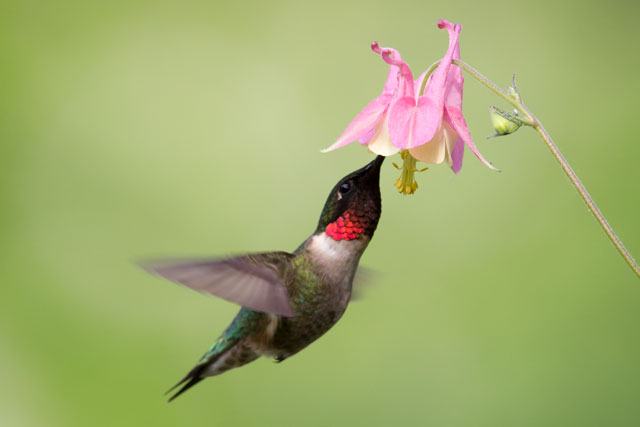Have you spotted hummingbirds in your garden yet?

Ruby-throated Hummingbird © Phil Sorrentino
These tiny, buzzing birds are a welcome sight in gardens across Massachusetts every spring, returning from their spring migration in late April and early May. With plenty of nectar-bearing flowers about now, they’re definitely back—and they are HUNGRY. The Cornell Lab of Ornithology says that hummingbirds have to consume their own weight in nectar and insects every day to survive!
Easy to Identify
The ruby-throated hummingbird is the only species of hummingbird that breeds in Massachusetts. The males are unmistakable with their bright red throats, while females and juveniles are just as stunning with their glossy, green plumage.
Learn More
Read hummingbird faqs. Looking for a new feeder? We’ve got plenty of options for you in the Audubon Shop.


Today, Sept. 5th ,2021, I had 4 hummingbirds eating at my nasturtium plantings. They were green bodied. Is this normal for hummingbirds and how long will they continue to be in the area (Yarmouth Port, on Cape Cod, MA.) ?
Yes, Ruby-throated Hummingbirds– our only hummingbird in the east– is green with a pale gray or white underside, and only adult males have the iridescent red throat. They can stick around into September but in parts of Mass with a milder climate (like the Cape) they may hang out for a while longer.
We have two hummingbirds in Bogart GA. One has a dark throat and one has a yellow throat.
Awesome.
We have many hummingbirds in the State of Washington. We have 2 feeders on our deck. Sometimes there are up to 10 birds but one bird is chasing them away. It is like a war out there……but fun to watch!
Hello from Crookston, MN..I just read that if you have a bully hummingbird you put 2 or 3 spaced a little ways apart but not to much And that is supposedly going to stop the bully. Just a thought.
Have an awesome weekend…God Bless
Our a Hummingbirds are so greedy and naughty. We have five nicely spaced feeders and there’s still always a couple of bullies that chase everybody away no matter what feeder they go to. No clue what to do. Guess we just sit back and watch the little fighter jets go at it!
Agreed. Love to watch the bird spats. Much nicer than the splats.
Saw a blue hummingbird in Quincy MA. yesterday…
I saw a blue hummingbird in Hudson MA today. I thought my eyes were deceiving me. I am curious to know what kind it is.
A male Hummingbird was here in Middleboro on April 21 this year. Know the females come soon. If they had babies last year, do the babies come back to the same area as the year before? Am I correct in thinking that the hummingbirds always come back to the same area as the year before?
Adults are likely to have site fidelity, but the young may return to a spot nearby, but not to the natal spot (risks breeding with a parent!)
I’m not getting hummingbirds at multiple clean feeders with fresh mix. It’s been a cold spring here on the Mass. coast. Could it be nesting red tailed hawks 200 yards away with a squawking juvenile that’s discouraging them? I’m mystified!
It’s definitely not the Red-tailed Hawks. Hummingbirds have a perimeter of safety, but it’s much smaller than 200 yards. This is the time of year when the females are caring for young, and are more interested in getting protein from insects than in sugar water, so this may be part of it. As you mention, it was very cold this spring so there may have been higher than normal mortality with hummingbirds.